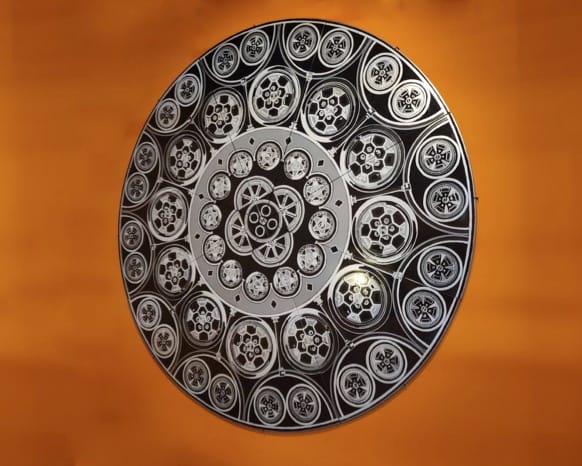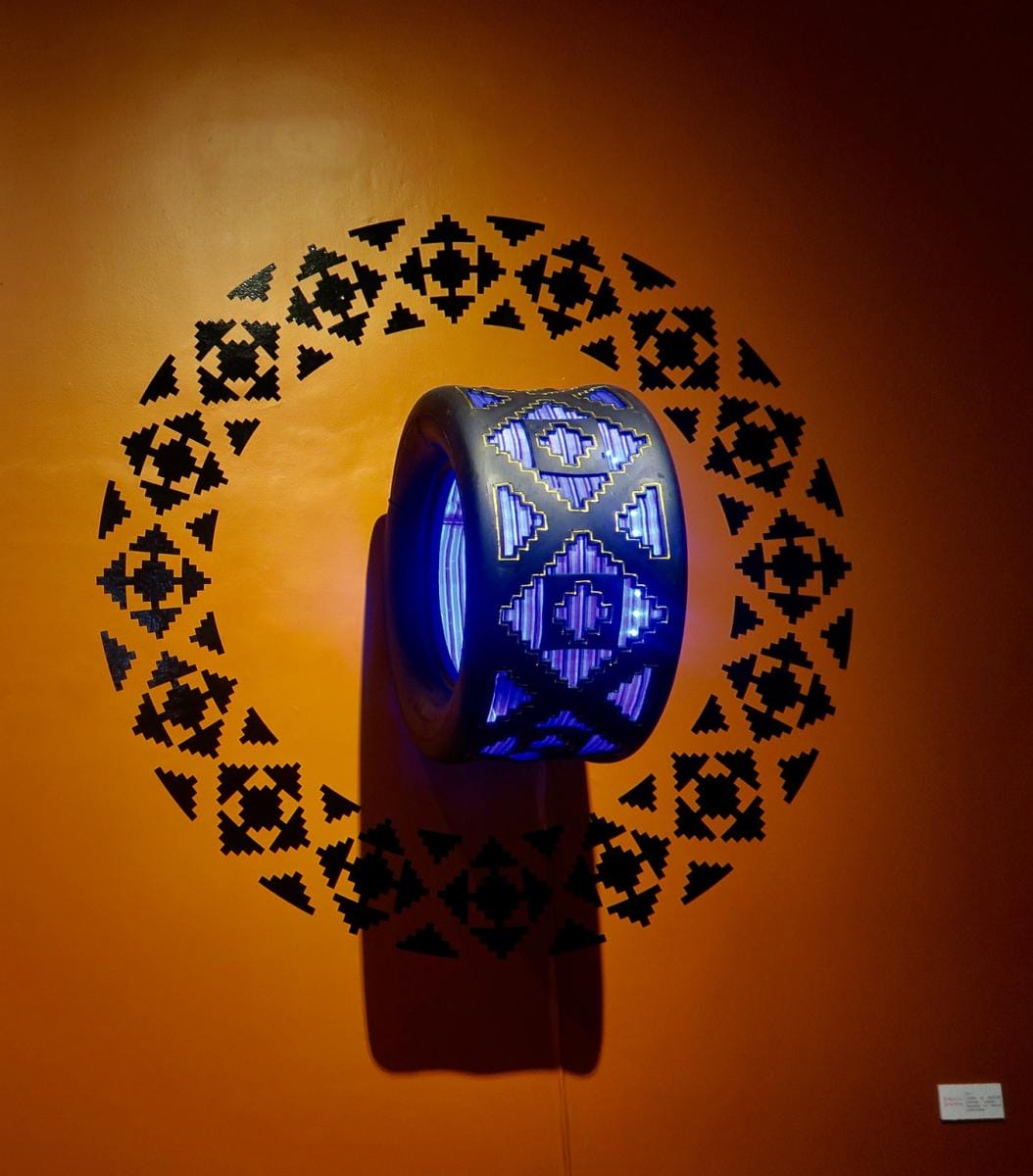Mexican artist Betsabeé Romero has risen to international renown for infusing an ordinary, everyday object with extraordinary symbolism: the car. The hallmarks of her practice are her artisanal transformation of industrial objects, and her fusion of ancient Indigenous artforms with contemporary culture. Such richly symbolic juxtapositions culminate in this exhibition, which transforms the gallery into a twenty-first century Mesoamerican ritual ball court.
Mesoamerica, which encompassed Mexico and Central America, has been inhabited by Indigenous communities who played the ritual ball game since before the 16th century BCE. The game had religious and political associations, often involving ritual human sacrifice. Here, the goal hoops have been crafted from NASCAR racing tires incised with motifs drawn from the cultures of Indigenous peoples from across the Americas. Colorful, hand-embroidered shawls called rebozos line the tires’ interiors. Visible through their patterned incisions, these rebozos’ craftmanship clashes with the exposed, rough rubber: a strategic contrast of traditional artistry with industrial fabrication.
According to Romero: “The Director of the Pirelli Factory [in Puebla, Mexico], which used to produce Formula 1 racing tires, defended Mexican workers and their factories’ location by proudly stressing that these tires are produced by many former artisans with very deep roots in traditional handicrafts, for which the Puebla region is celebrated.” The installation’s title, The Other Side of the Track, implies a subtle twist. Produced by Mexican artisans working in such factories for better pay, these racing tires foreground centuries-old artisanal traditions now being abandoned, as symbolized by the delicate handmade shawls they harbor inside.
At each end, this sacramental court culminates in a monumental, glowing silver “oculus” created from engraved and enameled hubcaps and car parts, reminiscent of the stained-glass rosettes above cathedral altars. Blending both historic and contemporary Indigenous heritage with ancient ritual and Catholicism, Romero’s exhibition embodies a sense of the sacred. It also references Mexican American and Chicano car culture as an artform, connecting the ancient American past with the contemporary present.
Organized by Vanessa Davidson, Research Curator of Latin American Art, Blanton Museum of Art
About the Artist
Betsabeé Romero (Mexico City, Mexico, 1963–present)
Al reverso de la pista is part of Betsabeé Romero’s long-term artistic project. Over the past twenty-five years, Romero has deconstructed the car, dissecting it like a living body and working with its constituent parts. She fuses elements of Mexican culture with universal symbolism, as well as themes relating to Mexican American and Chicanx culture, imbued into altered cars, tires, hoods, and hubcaps. Romero has also often connected the mobility of the car to the theme of immigration, considering tires themselves as “emblematic symbols of the theme of migration.” She affirmed, “I have taken up this iconography to speak about how migrants leave traces that surround us,” and also to show that they “have a place in our history, memory, and culture in Mexico.” Such themes are especially relevant in border states like Texas.
Credit
Betstabeé Romero: Al reverso de la pista [On the Other Side of the Track] is organized by the Blanton Museum of Art.
Support for this exhibition at the Blanton is provided in part by David and Ellen Berman.

![Betsabeé Romero, Al reverso de la pista [On the Other Side of the Track], 2025, (Installation Rendering), Courtesy of the artist.](https://blantonmuseum.org.staging3.juiceboxint.com/app/uploads/2024/06/Betsabee-Romero_Contemporary-Project_2025-1440x667.jpeg)

![Betsabeé Romero, Al reverso de la pista [On the Other Side of the Track], 2025, (Installation Rendering), Courtesy of the artist.](https://blantonmuseum.org.staging3.juiceboxint.com/app/uploads/2024/06/Betsabee-Romero_Contemporary-Project_2025.jpeg)
